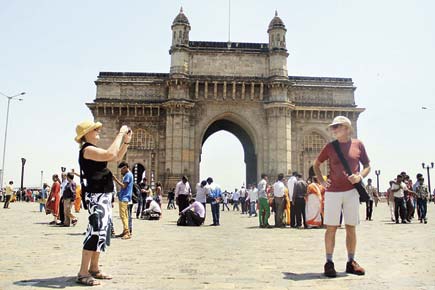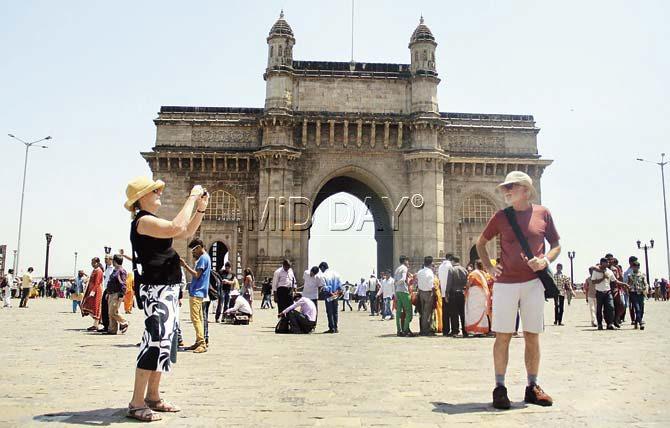A challenge from Charles Correa 30 years ago makes this writer explore the city’s arched splendours

 A journalist without a pen?” he asked as I fumbled to find mine in the recesses of a big bag. “Here’s an architect’s pencil instead.”
A journalist without a pen?” he asked as I fumbled to find mine in the recesses of a big bag. “Here’s an architect’s pencil instead.”
ADVERTISEMENT
That’s how I jotted Charles Correa’s quotes as notes. He was, memorably, the very first interviewee I had the privilege to meet at the start of a journey into journalism in 1984. Fresh out of college, raring to cut my teeth in a career I was set on from the school years, I sat quite nervously in his Opera House office. The editor’s stern forewarning rang in my ears: “Do your homework he’s the finest mind of our times.”

Foreigners look for a photo-op at the Gateway of India. Pic/Sameer Markande
The iconoclast who gifted the world seminal works too legendary to list gave a rookie reporter really great advice. “Talk to people like me if you must, but go out and write about the city,” he said. “Explore its public spaces, its markets, its water bodies, its archways...”

The arch on Warden Road at the entrance of the lane leading to Parsee General Hospital. Pic/Bipin Kokate
I will someday, I’d said, especially curious about the arches. It was a promise I clearly recalled last week at his funeral mass.
Keeping my word has brought a string of happy discoveries. Though there couldn’t be worse weather to tramp around town mapping antique arches.

The entrance of Bai Sakarbai Dinshaw Petit Hospital, Parel. Pic/Datta Kumbhar
The most familiar of these is Bombay’s enduring symbol. The Gateway of India at Apollo Bunder grandly combines 16th-century Gujarati, Mughal and British styles. As a kid I loved scoping its Indo-Saracenic contours. Thrilled to see my December2 birth date etched forever on the arch as the day which welcomed the visiting King George V and Queen Mary in 1911! They had actually arrived under a quickly assembled plaster-of-Paris replica of the Gateway; the yellow basalt avatar we know today came up in 1924. Irony ensured the last Brit battalion exited from the same gate, boarding ships that returned them to English soil.

The twin archway of Babulnath temple. Pic/Bipin Kokate
A quaint smaller arch arrests pilgrims by surprise as they pour into Mahalaxmi Mandir through it. Supported by Corinthian pillars crowned by a clock, this bears the words ‘1905: Prince’s Triumphal Arch’. Brahmin priests dispense prasad around the European structure, even a few Haji Ali-bound devotees peer in to admire. Think of it as a fantastic fusion of secular culture.
Another holy of holies, Babulnath Temple, boasts twin arches bringing flocks of the faithful within its inner precinct. It reflects a strong ‘public’ face and form of architecture. Few places of worship more directly spill into a streetscape as this, built in 1780 shaped like a Babul tree. Flower and incense sellers go about their business amid throngs of Shiva bhakts in a daily drama celebrating the mix of plebeian and divine.
Between these sacred gateways rises an arch lovely in limestone. It straddles the width of Bomanjee Petit Lane, off Warden Road, in a 28-feet span greeting pedestrians and patients since the start of the 20th century. Heralding the path that leads to the beautiful gardens of BD Parsee General Hospital, the arch once probably marked the boundary of the grounds when the property opened as a facility to help cope with a bubonic plague outbreak. Its earlier avatar was The Cumballa Hill Family Hotel.
More midtown marvels of such ‘social architecture’ wait to share their stories. Not far from where the name of her son Bomanjee graces the famed medical institution, Lady Sakarbai Petit likewise lent hers to a compassionate cause. Erected in 1874, the Bai Sakarbai Dinshaw Petit Hospital for Animals in Parel, locally dubbed ‘Bail Ghoda Hospital’, extends entry to its verdant premises under an arch mounted with charming sculpted dog, cat and bullock figures.
An unusual arch of appreciation has loomed over the city’s primary RTO (regional transport office) at Tardeo, again since the early 20th century. Anyone lining up for driving licences of MHO1-marked vehicles gets to view a historic inscription carved on it. The RTO compound originally housing barracks and horse stables for the Governor’s bodyguards, the crowded alley outside is still called Bodyguard Lane. The plaque reads: ‘To commemorate the unfailing interest in their welfare which resulted in the erection of these lines by his Excellency Sir George Lloyd, Governor of Bombay, this tablet was erected by officers and men of his bodyguard as a token of their gratitude, 1st December, 1921.’
If stones could speak, what tales they might tell. Four of these six stunning archways stand close to picturesque waterfronts. My mind casts back to what Correa so rightly observed at a book launch in the 1990s - “Bombay is that finest of things: a city on the sea.”
Meher Marfatia loves Mumbai. And adores Bombay. Reach her on: mehermarfatia@gmail.com
 Subscribe today by clicking the link and stay updated with the latest news!" Click here!
Subscribe today by clicking the link and stay updated with the latest news!" Click here!






